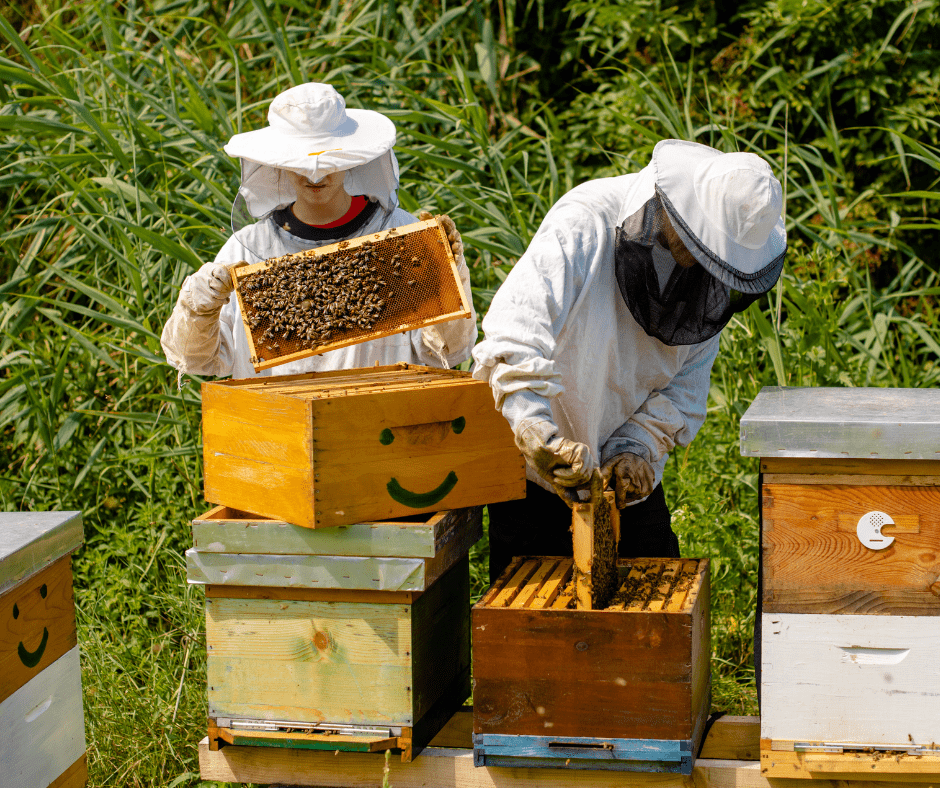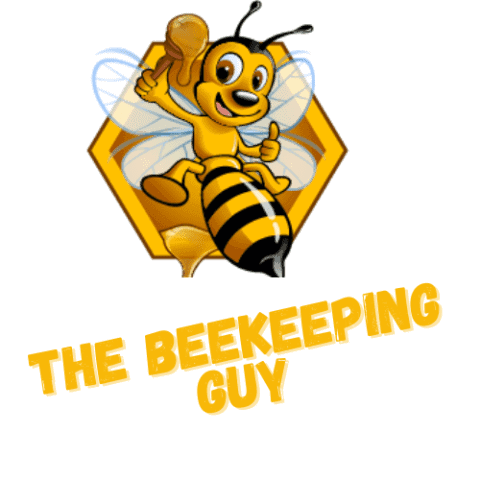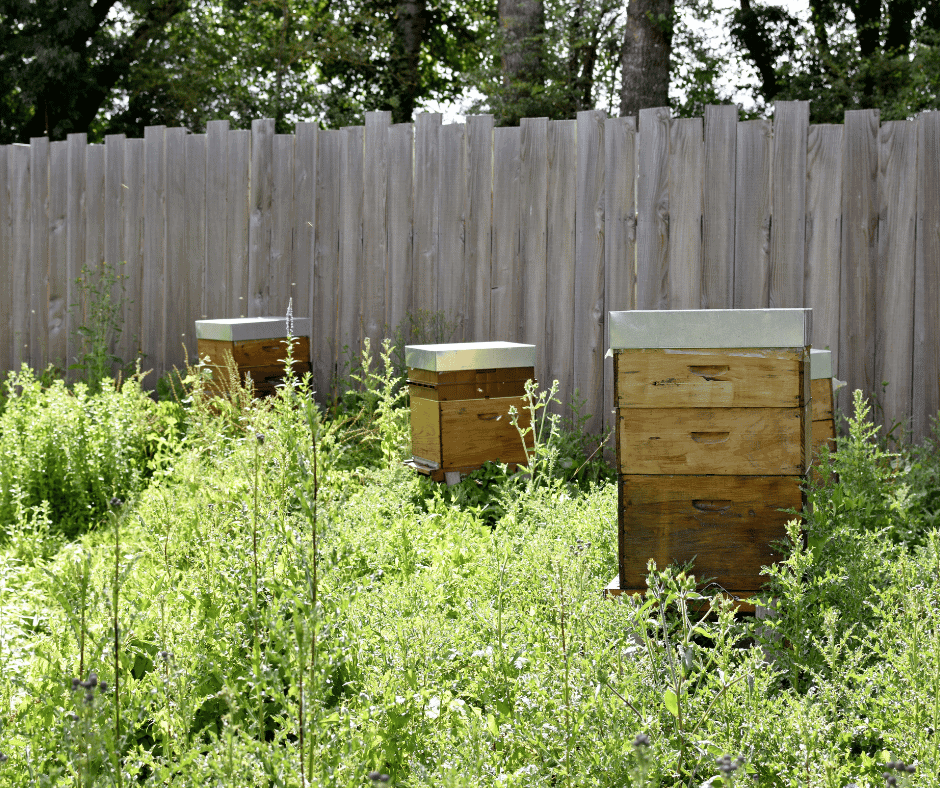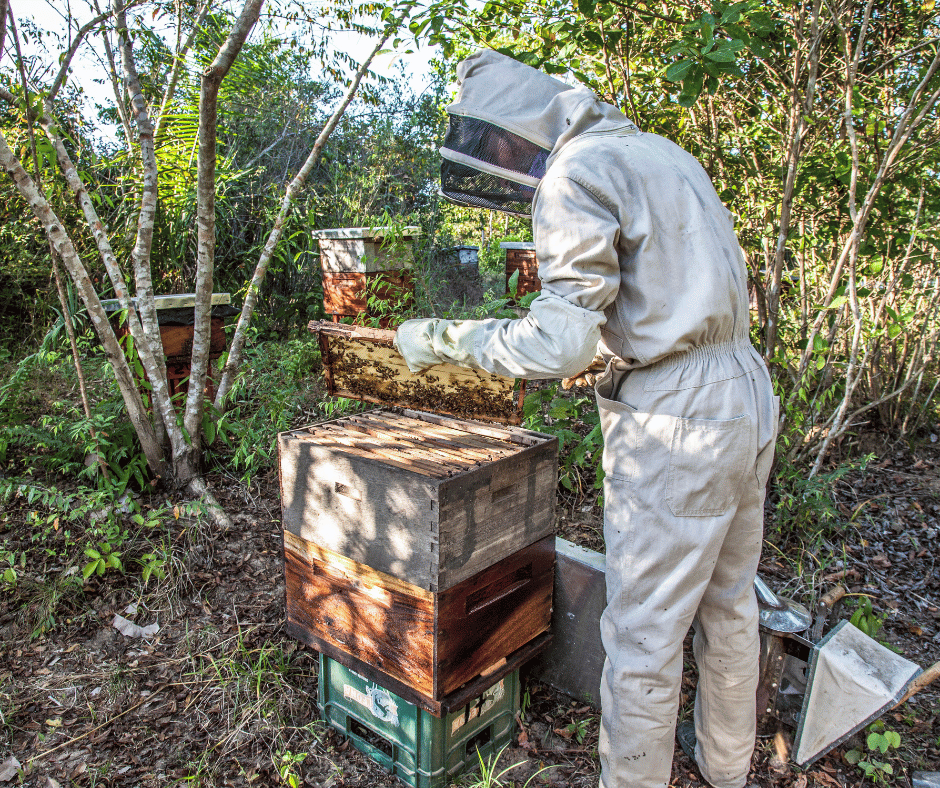
For those who dream of becoming beekeepers, having your very own hive is like being party to this secret world – but where do you start? What are the best bee hives for beginners? For those just starting out in the world of beekeeping, it’s important to purchase a bee hive that is easy to manage and maintain. I’d recommend either a Top Bar or Warre hive for beginners looking to get started with bees.
But there are some other options and there are many other things to consider. We’ll take a closer look and help guide you on your journey into beekeeping.
Beekeeping can be an incredibly rewarding hobby; not only will it bring with it plenty of educational opportunities and experiences, but you’ll also have the satisfaction of knowing that your work helps sustain our valuable pollinators! However, before we explore which type of beehive is right for beginner beekeepers, let’s first look at what factors you should consider when making your decision.
In order to make sure that both you and your bees get off to the best possible start, there are several important things to think about when selecting the perfect home for them. Price point, materials used, size, and ease of use are just some aspects that require careful consideration – so let’s dive deeper into each one in turn!
Table of Contents
The Importance Of Choosing The Right Beehive For Beginners
Choosing the right beehive is a crucial step in becoming a successful beekeeper. It’s important to select one that best suits your needs and environment, as this will determine how well you can care for your bees. But there are a few other things to consider.
Beekeeping starter kits include not only the hive itself but also other essential items such as protective clothing, feeders, smokers, and tools. A bee hive starter kit allows beginners to get everything they need without having to purchase each item separately.
Small beehive kits are perfect for those just starting out in beekeeping or who don’t have much room on their property. These kits often contain all of the necessary components needed to start an apiary: frames, bottom boards, supers, covers, and more.
Understanding where to buy bee hives is key when selecting the right beehive; there are many reputable suppliers online with great customer service should you need help choosing the correct model.
When learning how to start a beehive it’s vital you choose one that meets your individual circumstances – whether it’s size-related or budget-oriented – so you can ensure your bees receive proper care throughout their lives. With these tips in mind, let us now turn our attention toward understanding the different types of beehives available.
Understanding The Different Types Of Beehives
There are many types of beehives from which to choose, and understanding the different options will help you make an informed decision. Like a puzzle piece in place, each type has its own unique purpose that is suited best for certain conditions and goals.
The Langstroth hive is one of the most popular hives among beginner beekeepers because it fits together like pieces of a jigsaw puzzle and can easily fit into any backyard or farm setting. It comes as part of a complete kit with all the necessary parts included such as frames, boxes, follower boards, and more.
Top bar hives are another type that offers easy access for inspection without having to remove too many components at once. They usually come with their own wooden box and top bars so no additional equipment is required – perfect for first-time beekeepers who want something simple yet effective. The only downside is that these hives require regular maintenance due to their open-air design but overall they provide great value for money.
Now armed with this knowledge about the various styles available, it’s time to consider some factors when choosing your beehive kit.
Factors To Consider When Choosing A Beehive
When deciding upon a beehive, there are several factors that beekeeper beginners should consider. First and foremost is the size of your hive. You will need to decide whether you want a larger colony or a smaller one. If you plan on starting with just a few bees, then getting a small bee hive may be best for you. There are also starter kits available which include everything you need to get started in beekeeping. These typically come with all the necessary equipment such as protective clothing, a smoker, frames, foundation wax, feeders, and more.
The type of beehive is another important factor when making your decision. Langstroth hives are popular among experienced beekeepers due to their versatility and ease of use but they can be quite expensive if bought new.
Warre hives offer an affordable option while providing an excellent environment for your bees to thrive in. Lastly, it’s important to determine how many bees you intend to buy before purchasing any supplies. A beginner beekeeper kit usually contains enough space for around 3-5 frames so make sure you have enough room for the number of bees that you plan on keeping!
Once you have decided upon these elements, you can begin researching different suppliers who sell honeybees or purchase complete packages from local apiaries or online stores. By taking time to research each supplier’s offerings carefully, it’s possible to find quality products at competitive prices that fit within your budget and meet your needs perfectly!
Tips For Setting Up Your Beehive
It’s estimated that there are over 4.5 million beekeepers in the world, so if you’re considering starting your own hive of bees, you’re part of a large and growing community! Before getting started on your journey to becoming a beekeeper, it’s important to understand what is needed for setting up a beehive. Here are some tips to help make sure everything runs smoothly:
- Start with a beekeeping starter kit – This includes many essential items such as protective clothing, gloves, hives and frames, tools, feeders, and more.
- Have all the necessary supplies ready – You’ll need things like foundation sheets (or wax), an inner cover, an outer cover, hive stands or blocks, and top bars.
- Follow best practices when looking after bees – Make sure to check the hive regularly for signs of disease and infestation; keep records of any treatments used; use smoker correctly; feed bees during times of dearth (lack of nectar sources).
These three steps will ensure that you have all the basics covered for setting up your beehive. With this knowledge under your belt and the right equipment at hand, you can confidently move on to selecting the perfect bee hives for beginner beekeepers.
The Top Beehives For Beginner Beekeepers
Starting beekeeping can be a daunting task. With so many options on the market, finding the right beekeeper’s kit to get you started can seem overwhelming. But fear not! We’ve done the research and compiled top-rated bee hives for beginners that are perfect for those who want to start their own hive.
| Beginners Beehive Kit Name | Rating |
|---|---|
| Honey Lake Complete Beehive Starter Kit | 4.6/5 stars |
| Amish Made in USA Complete Langstroth Beehive – The Starter Kit | 4.3/5 stars |
| Bee Castle 10-Frame Bee Hive Starter Kit | 4.6/5 stars |
The Honey Lake Starter Kit
The Honey Lake 10-Frame Bee Hives and Supplies Starter Kit is a complete beehive kit that comes with everything needed for beekeeping. It includes a wax-coated solid bottom board, top cover, inner cover, queen excluder, entrance reducer, and a set of beekeeping tools such as an uncapping tool, bee smoker, and hat veil. The kit is made of high-quality stainless steel, plastic, and pine wood, making it sturdy and durable for long-term use.
The kit is safe and easy to use for both beginners and experienced beekeepers. The veil hat provides effective protection from bee bites and has excellent ventilation. This feature makes the kit ideal for beekeepers who want to check on their bees, collect honey, and perform other beekeeping activities safely and conveniently. Overall, the Honey Lake 10-Frame Bee Hives and Supplies Starter Kit is an excellent choice for anyone looking to start beekeeping or expand their beekeeping supplies.
[amazon box=”B09P3TCT4T” description=”The Honey Lake 10-Frame Bee Hives and Supplies Starter Kit is a complete beehive kit that comes with everything needed for beekeeping”]
The Amish Complete Langstroth Beehive
The Amish Made in USA Complete Langstroth Beehive – Starter Kit is a perfect solution for beginners who want to get started with beekeeping. This beehive starter kit is made in the USA by the Amish of Ohio and comes with all the essential tools and equipment required to start beekeeping. The deep brood box is made from Eastern White Pines of Michigan and Pennsylvania, making it sturdy and long-lasting. The CellTech deep brood frames and foundations are made from black food-grade plastic dipped in 100% beeswax, which makes it easy for beekeepers to assemble the frames and foundations with ease.
The kit is ‘Nuc ready,’ which means that it comes with three frames, making it convenient when purchasing your bees as a ‘5 frame Nuc.’ Additionally, the kit includes all the necessary accessories like a screened bottom board, telescoping top cover, inner cover with a mason jar size feeder hole, and an entrance reducer. Moreover, the kit comes with sheepskin leather gloves, a breathable protective jacket, a reinforced upright veil, the original smoker, and a curled hive tool, making it a complete starter kit for beekeeping. Overall, the Amish Made in USA Complete Langstroth Beehive – Starter Kit is an excellent investment for beginner beekeepers and is well worth the purchase.
[amazon box=”B08WHQ7YVS” description=”The Amish Made in USA Complete Langstroth Beehive – Starter Kit is a perfect solution for beginners who want to get started with beekeeping.”]
Bee Castle 10-Frame Bee Hive Starter Kit
The 10-Frame Bee Hives and Supplies Starter Kit is a complete kit for beekeepers, containing everything needed to get started with beekeeping. The kit includes a wax-coated assembled deep brood box, solid bottom board, telescoping top cover, inner cover, queen excluder, and entrance reducer, all made of high-quality cedarwood and coated with beeswax for durability. In addition, the kit comes with a beekeeping supplies tool set, including a premium bee smoker and a bee frame holder, along with 19 other necessary beekeeping tools.
The kit also includes a free-size bee suit, which includes a beekeeping jacket and pants, as well as leather gloves. Furthermore, the kit comes with 10 unassembled deep brood frames made of high-quality pine wood and 10 foundation sheets made of black food-grade plastic dipped in 100% beeswax.
[amazon box=”B09HX21HCL” description=”The 10-Frame Bee Hives and Supplies Starter Kit is a complete kit for beekeepers, containing everything needed to get started with beekeeping”]
Whether you choose one of these three recommended beehives or opt for something else entirely, rest assured knowing that there are plenty of quality starter kits available on the market today specifically designed with beginners in mind.
Now let’s take a look at the most popular styles of beehives used today.
The Langstroth Beehive

For those looking to become beekeepers, this classic hive design offers the perfect starting point. With its easy setup process and inherent durability, it’s no wonder that the Langstroth has been the go-to beekeeping option for over 150 years.
Designed to make beekeeping easier than ever before, this type of hive allows beginners to take control of their hives quickly and easily. Every component needed to set up a successful colony can be found within one hive body – meaning you don’t have to worry about sourcing specialized pieces or settling for subpar materials when caring for your bees.
This dependable structure gives newbie beekeepers the confidence they need to start taking care of their own apiaries without fear or hesitation. Plus, since there are so many resources available online today on how to keep bees in a Langstroth beehive, you’ll never feel alone as you become an expert beekeeper!
Pros And Cons Of The Langstroth Beehive
The Langstroth beehive is a popular choice when it comes to keeping bees, however, like any other option, there are pros and cons associated with this type of hive. It’s important for beekeepers to understand the advantages and disadvantages before deciding if the Langstroth beehive is right for them.
Pros
- Ability to buy bee kits that include all the necessary components
- Easily moveable from one place to another
- Provide an ideal size for housing a large number of bees
Cons
- 10 frame hives are much wider than bees’ natural habitat
- Inspections can be a little invasive for the bees
- The actually overall frame is a little heavy
One of the biggest benefits of choosing a Langstroth beehive is that it’s easy for beginners to purchase beekeeping starter kits which come equipped with all you need to get started. This includes frames, boxes, and lids so you don’t have to worry about where to source those items yourself.
Additionally, many companies offer complete packages including tools, protective gear, and even live colonies! Having everything in one package makes getting started simpler than ever before.
Another great feature of the Langstroth beehive is its portability. With some basic knowledge of how to safely transport a colony of bees, they can easily be moved from one location to another without disrupting their home too much.
The design allows beekeepers flexibility when it comes time to find new homes or locations for hives; this makes managing multiple colonies easier as well.
Finally, because each frame has room for several hundred honeybees in each box, this style of hive provides plenty of space for your growing colony – whether you’re just starting out or already have an established group.
Overall, the Langstroth beehive offers both convenience and practicality when it comes time to select a hive setup. While considered standard by most experts within the industry today, potential drawbacks should also still be weighed up against other options such as top bar hives before making your final decision.
The Top Bar Beehives

Top bar beehives are great for beginners because of their ease of use. They come in a variety of sizes, which makes it easy to find the right one for your space and needs. Plus, they don’t require much setup or maintenance once you get them up and running.
With a bee kit, starting a bee hive is simple – just assemble the parts according to directions, add bees when they arrive, and voila! You have an operational mini bee hive ready to start collecting honey.
These small beehives can fit almost anywhere; even if you only have a small garden area or balcony that’s suitable for keeping bees. And since they’re designed with the beginner in mind, these hives rely on basic principles so you don’t need any prior experience to understand how things work.
It’s also relatively inexpensive compared to other types of hives out there – ideal for those just starting out with their own apiary operations.
This type of beehive offers lots of advantages for newbies who want to enjoy the rewards (and challenges!) Of beekeeping without breaking the bank. From its affordability and ease-of-use features to its versatility as far as placement goes, top bar beehives may just be your best bet when it comes to getting started with this fascinating hobby. Now let’s look at some pros and cons associated with this popular option…
Pros And Cons Of The Top Bar Beehive
The Top Bar beehive is a great option for beginner beekeepers. It’s easy to use and requires little space, making it an ideal choice for those new to the hobby or with limited resources. This type of hive provides many benefits, including cost savings and convenience, but there are also some potential drawbacks that should be considered before starting up your own top bar hives.
Pros
- Low Cost
- Easy on the back and easy to use
- Inspections are fairly non-invasive
Cons
- Limited space
- Limited growth potential
- Risk of swarming and disease
The low-cost nature of this kind of beekeeping equipment makes it a great choice for those just starting out in the field. Plus, since you don’t need any special tools or extra supplies to manage these colonies, it can save time and money when compared to more complicated setups. Additionally, the simplicity of setting up and managing the colonies means that even novice beekeepers can become proficient quickly.
On the other hand, due to their small size, these hives are limited in terms of apiary growth potential; if you’re planning on keeping several colonies at once (which isn’t unheard of!), then you’ll have to consider another type of hive. There’s also an increased risk of swarming and disease due to having fewer bees per colony than larger box hives would offer – something else worth considering before investing in one.
In sum, while top bar beehives certainly have their advantages – especially when it comes to cost-effectiveness and ease-of-use – they may not provide enough space or protection against certain risks without additional investment in supplies like queen excluders or swarm traps. With careful consideration given to how much space is available as well as budget constraints, though, these kinds of hives can still make excellent starter homes for newbie beekeepers! Transitioning into the next section about Warre Beehives…
The Warre Beehive

The Warre beehive is an excellent choice for beekeeping beginners. It’s a top bar hive that has been used in Europe and the United States since the early 20th century. The design of this type of beehive provides plenty of space for bees to move around, making it easier for them to care for their hives. Plus, many beekeepers love how Warré hives look.
If you’re looking for where to buy bees and supplies for your Warré Hive, there are several online stores that offer everything you’ll need. Prices vary depending on what kind of bees and hive parts you purchase, but typically you can get started with a basic setup for under $500 USD. This includes the hive body, frames, foundation sheets, tools, and protective gear like gloves and veils.
Pros And Cons Of The Warre Beehive
The Warre Beehive has been a go-to choice for beginner beekeepers for years. It is easy to use, requires minimal maintenance, and provides plenty of benefits that make it an ideal hive for those just starting out in the world of beekeeping. But what are some of its pros and cons? Here’s a look at how this type of beehive stacks up:
Pros
- Ease to assemble
- Low cost and can be self-built
- Bees can move freely throughout the hive
- The natural design allows great airflow
Cons
- Lack of visibility of interior
- No access to honeycomb cells
- Challenging construction
- Lower honey yields
Overall, while there are certainly some drawbacks associated with this style of beehive, it still remains one of the most popular choices among beginner beekeepers and can even be constructed from scratch, if you know your way around wood.
With proper installation and care, hobbyists can enjoy many successful harvests year after year using this type of hive system. That being said, before deciding on any particular type of beehive it’s best practice to do research and weigh all options carefully prior to making a final decision about which will work best for each individual situation.
Conclusion
It’s important for beginner beekeepers to understand the different types of beehives and what factors should influence their decision when choosing one. After researching the top bar, Warre, and other hives available, As I stated in the introduction, I’d recommend either a top bar or Warre hive for beginners looking to get started with bees.
Top bars are ideal if you’re on a budget as they can often be made at home from recycled materials. The Warre is more expensive but it’s known for being easier to maintain since its design allows honeybees to build comb naturally without the need for regular inspection by the beekeeper.
Beekeeping is an incredibly rewarding hobby that has been around for centuries, and with some careful research and preparation, anyone can begin beekeeping – no matter which type of beehive they choose.



